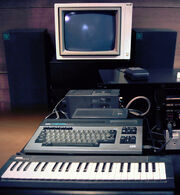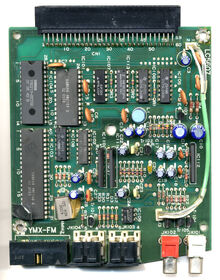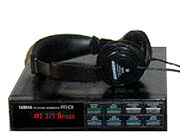An odd personal computer / synthesizer combination introduced by Yamaha in 1984. The basic CX5m consisted of a personal computer based on the Zilog Z80 processor, with 64 Kbytes of memory; a version of the BASIC programming language in ROM (into which the computer booted up by default), and a slot for plugging in cartridges containing other software in ROM, or battery-backed RAM for data storage. The entire basic unit was encased in a box about the size of the included alphanumeric keyboard; a composite video output drove an external monitor.
The synthesizer part was contained in a module that plugged into the base unit. It contained an implementation of Yamaha's 4-operator FM synthesis, 8-voice polyphonic. The module provided MIDI in and out ports, and stereo audio out. A BASIC program could make the synth play notes using one of a selection of 48 (later 64) preset sounds. Using the full capabilities of the BASIC language, the clever programmer could do some interesting things in sequencing or algorithmic composition. However, precise timing with the code was somewhat difficult, and there was no means to synchronize to an external sequencer.
Yamaha eventually offered about 15 ROM software cartridges. Notable among these was a software cart that transformed the CX5m into a programmer for the Yamaha DX7 and TX7, with onscreen graphical editing of the parameters -- much superior to editing using the DX7's own two-line character display and one-knob interface. Other programs allowed accessing the capabilities of the CX5m's own synth, including a patch editing program and one called "Music Macro", which was basically a software sequencer with some coding provisions. Other available cartridges included programmers for several other Yamaha synth models, and a few that were non-music-related, including a word processing package.
The big problem with all of these was that the computer only had one cartridge slot. A user would have had to be able to insert a memory cartridge in order to save a file from a program -- but the program cartridge was already occupying the slot, and since the computer ran the program directly from the cartridge ROM, there was no way to remove it without terminating the program. So there was no way to save data from any of these programs, which meant that none other than the external-synth programmer packages were actually useful. Yamaha was very late offering any other form of storage; a floppy disk drive wasn't available until 1986 (and it was hard to find and very expensive), and Yamaha never offered the promised hard disk unit.
Another big problem was that the original synth module, the SFG-01, had extremely limited MIDI capabilities. The MIDI In did not recognize note or performance data; its sole purpose was to receive system exclusive data from the other Yamaha synths for which a programming cartridge was available. Yamaha offered several models of dedicated keyboard, which interfaced to the CX5m via a proprietary interface; all of these were very basic, lacking velocity, aftertouch, a pitch wheel, or any other performance controls, so although the MIDI out functioned with this keyboard, it could only send basic note data. Code running on the computer could cause notes to play, but not send or receive MIDI, nor could it change any patch parameters. Yamaha refused to release the system documentation that would have made it possible for user-written code to overcome these limitations. (A few pieces of example code did eventually leak out, including some that provided access to the MIDI ports.) Later production units came equipped with a revised synth module, the SFG-05, which allowed the synth to be played by incoming MIDI data and extended some of the other capabilities, including making the unit multitimbral. The SFG-05 was offered as an upgrade to the earlier model, but since it cost nearly as much as a new CX5m, few users chose this upgrade.
The CX5m adhered to a Japanese personal computer standard called MSX; this included both the operating system (similar to early versions of MS-DOS) and the peripheral interfaces. A particular problem in this area was that the mouse interface was incompatible with IBM PC standards, and MSX-compatible replacement mice were hard to find even then (and nearly impossible now). Also, the MSX operating system was already showing its age by 1984, falling behind the capabilities of later versions of MS-DOS and nowhere near that of even the first version of Windows. And third-party software support was almost nonexistent.
All of these factors combined to make the CX5m a big disappointment to most buyers. There were many "This would be great if only this missing piece were avaialble" types of capabilities, but Yamaha in most cases never got around to providing those missing pieces. In the end, Yamaha seemed content to advertise it as simply a DX7 programmer, and eventually much less expensive third-party options appeared for that purpose, eliminating the CX5m's market. Yahama withdrew it by 1988, and likely no more than 1000 were sold. Since the synth modules themselves don't do anything that other Yamaha 4-op FM synths of the era couldn't do, there is no particular collector market for the CX5m.
Overview[]

Yamaha CX5M Music Computer set
Yamaha CX5M is an MSX-based personal computer, specializing in music and sound production. It was originally released as the CX5 in 1983,[1][2] before being upgraded to the CX5M in 1984. The CX5 was a YIS-303 MSX computer with a built-in SKW-01 sound module,[2] while the CX5M was a YIS-503 Diabolik MSX computer with a built-in SFG-01 FM Sound Synthesizer Unit sound module.[3][4][5] The CX5M was marketed as an electronic musical instrument,[3] and was one of the most anticipated electronic music products of 1984.[4]
It expands upon the normal features expected from these systems with a built-in eight-voice FM synthesizer module, manufactured by Yamaha Corporation,[6] along with a MIDI interface.[7][4] It came with graphical music software for digital synthesis and a sequencing,[7][4] capable of synthesizing and sequencing sounds and rhythms,[8] with its internal FM synthesizer or external MIDI devices.[7] It provided synthesis, composition tools, and a 4-track MIDI sequencer, available on different cartridges.[9]
The SFG-01 FM Sound Synthesizer Unit, released in 1983,[5][10] uses several chips, including a Yamaha YM2151 FM sound chip, YM3012 stereo DAC, YM2210 MIDI communications chip, YM2148 keyboard scanning chip,[4] and YM2148 MIDI UART.[10] It also has stereo audio outputs, an input for a purpose-built four-octave keyboard, and a pair of MIDI Input/Output ports. It had limited MIDI support on the original CX5M model,[4] with only management of data from a Yamaha DX7 digital synthesizer. The YIS-303, CX5, YIS-503 and CX5M computers could be upgraded with the SFG-01 FM Sound Synthesizer Unit II sound module, released in 1984,[10] featuring an upgraded Yamaha YM2164 sound chip[10] and full MIDI support, which could be used for normal MIDI. The SFG-05 module came integrated with the second CX5M revision, the CX5M II.[3]
Specification[]
The CX5M was built to the MSX standard, which included slots for inserting programmed cartridges. These extended the machine's capability, accepting a range of games, office applications and so on. Yamaha produced a range of cartridges including a programmer for Yamaha's DX range of FM keyboards and a real-time sequencer. Two of these, the Voice Editor and Music Composer, allowed the user to program a bank of 48 sounds for the CX5's own built in synthesizer and to sequence up to eight channels of music, controlling the built-in module or external instruments via MIDI, in step-time using a musical-stave input screen.

Yamaha SFG-01
FM Synthesizer Unit (internals):
8ch 4op FM sound chip YM2151 was used for multitimbral sounds and composite sinusoidal modeling (CSM) singing voice.
Three versions of the CX5M were released. The first contained as its FM module the SFG-01, which could not receive external MIDI note information; it required a proprietary keyboard and only used its MIDI port was an output to send data to Yamaha's then-flagship DX7. The second version, the CX5M II (or CX7M/128 in Japan[11][12]), upgraded the FM system to the SFG-05, which supported MIDI input and thus allowed the internal FM synth to be played by any external MIDI keyboard. There was also a later CX5M II with some smaller differences.[13]

Yamaha FB-01 FM Sound Generator and a headphone on it
Later, Yamaha released the Yamaha FB-01 MIDI module, which was effectively an SFG-05 in a standalone, portable case.[14] The FB-01 was released in 1986.[15]
Software[]
Music software were released on MSX cartridges, including:[3][4]
- YRM-101 / YRM11: FM Music Composer
- YRM-102 / YRM12: FM Voicing Program
- YRM-103 / YRM13: DX-7 Voicing Program
- YRM-104 / YRM15: Yamaha FM Music Macro
- YRM-105: DX-9 Voicing Program
- YRM-301: MIDI Recorder YRM-301
- YRM-302: RX Editor
- YRM-303: MIDI Macro & Monitor
- YRM-304: TX-7 Voicing Program
- YRM-305: DX-21 Voicing Program
- YRM-501: FM Music Composer II
- YRM-502: FM Voicing program
- YRM-504: Yamaha FM Music Macro II
- YRM-506: FB-01 Voicing Program
Notes[]
- ↑ Martin Russ, Sound Synthesis and Sampling, page 85, CRC Press
- ↑ 2.0 2.1 Yamaha CX5, Old Computers
- ↑ 3.0 3.1 3.2 3.3 YIS-503 / Diabolik, Old Computers
- ↑ 4.0 4.1 4.2 4.3 4.4 4.5 4.6 David Ellis, Yamaha CX5M, Electronics & Music Maker, October 1984
- ↑ 5.0 5.1 Yamaha SFG-01, MSX Resource Center
- ↑ Yamaha CX5M Music Computer. SonicState.com.
- ↑ 7.0 7.1 7.2 Yamaha CX5M Music Computer Flyer, Yamaha
- ↑ Helen Casabona, David Frederick, Advanced MIDI Applications, page 15, Alfred Music
- ↑ Happy birthday MIDI 1.0: Slave to the rhythm, The Register, August 2013
- ↑ 10.0 10.1 10.2 10.3 Yamaha SFG, MSX Resource Center
- ↑ CX7M/128 (discontinued) (Japanese). Yamaha. — for details, see CX7/128.
- ↑ CX7/128 (discontinued) (Japanese). Yamaha.
- ↑ Eirik Lie. CX5M FAQ.
- ↑ FB-01 is an independent Z80 microprocessor system that sends and receives data from YM2164. Mages (May 2010). Yamaha FB-01.
- ↑ Yamaha FB-01, Vintage Synth Explorer
References[]
- Yamaha Music Computer CX5M Owner's Manual. Yamaha. http://download.yamaha.com/api/asset/file/?language=hu&site=hu.yamaha.com&asset_id=4605.
- Yamaha Music Computer CX5MII Owner's Manual. Yamaha. http://download.yamaha.com/api/asset/file/?language=hu&site=hu.yamaha.com&asset_id=4607.
External links[]
- The Yamaha CX5M Music Computer Resource. CX5M.net.
- Yamaha cx5m MSX. The MSX Plaza (June 1, 1999).
- Eirik Lie. CX5M FAQ.